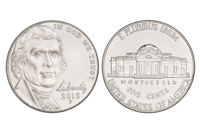Posted on February 15, 2021

Issued in 1866, the American nickel was one of the first coins created. Known then as the half dime, the nickel is the only coin that is called by its metal content. Over the years, the coin has evolved and remains a strong option for collectors.
The first 5-cent piece wasn't known as the nickel, as it was not made of that metal. The Mint Act of 1792 stated that all coins had to be made of gold, silver or copper, so this 5-cent piece was made out of silver and called the half dime. The biggest changes involve the coin's design.
The need for the nickel and other coins of smaller denomination came about after the American Civil War when people began hoarding coins for their value. Shortly after a bill passed in 1865 to create a 3-cent piece, Mint Director James Pollack suggested creating a 5-cent piece composed of 75% copper and 25% nickel [1]. It was also agreed that this new coin weighs 5 grams.
The obverse of the coin was similar to a 2-cent piece originally introduced in 1864, although the nickel's design is slightly different. A large shield is shown, with vertical lines below and horizontal lines above. There's a large cross on the top, while arrows are on the side and bottom. 'IN GOD WE TRUST' is above and the date is below.
On the reverse, there's a large number '5' that sits within a circle of 13 stars. Coins produced in 1866 and some in 1867 had rays placed between the stars. The rays were removed in 1867 because the design was too hard to strike clearly.
From 1866 to 1873, the nickel and half dime had been struck together. But after the Mint Act of 1873, the half dime was discontinued, allowing the nickel to be the only 5-cent denomination [2]. The Liberty Head, designed by Charles Barber, was the next nickel created.
The obverse has Liberty with a headband saying 'LIBERTY.' Cotton and wheat are woven into her hair, and 13 stars surround her head with the date below. On the reverse is a Roman 'V' with a wreath of wheat and ears of corn. The words 'UNITED STATES OF AMERICA' and 'E PLURIBUS UNUM' circle the image. There is no denomination on the coin.
Also known as the Indian Head nickel, the Buffalo Nickel had the first animal on an American circulating coin that wasn't an eagle. It remained the only non-eagle animal on a coin until 1999 when the 50 State Quarter Program introduced several animals to its coins [3].
Designed by James Earle Fisher, the Buffalo Nickel shows a Native American's right-side profile on the obverse. He combined the characteristics of three chiefs (Two Moons of the Cheyenne, John Big Tree of the Seneca Nation and Iron Tail of the Sioux) to model the Indian head. 'LIBERTY' is on the coin's right side, while the date is near his neck.
On the reverse, Fisher used the bison named Black Diamond from the New York Central Park Zoo as his inspiration. The bison stands on a mound, and below the mound is the denomination of 'FIVE CENTS.' Above the bison is 'UNITED STATES OF AMERICA' and 'E PLURIBUS UNUM.'
As the longest-running series for the nickel, the Jefferson Nickel came about after the Lincoln Penny and Washington Quarter, making it the third coinage to feature a former president [4].
Auto stylist Felix O. Schlag won a contest and designed the original Jefferson Nickel that shows Thomas Jefferson's left-facing portrait with 'IN GOD WE TRUST,' 'LIBERTY' and the date. The reverse has Jefferson's Monticello home, 'E PLURIBUS UNUM,' 'UNITED STATES OF AMERICA,' 'MONTICELLO' and 'FIVE CENTS' all inscribed.
This design remained constant for six decades until several changes occurred between 2004 and 2006 to commemorate the bicentennial of the Louisiana Purchase as well as Lewis and Clark's expedition westward. During these three years, the Westward Journey Nickels had four different reverse designs and two new Jefferson portraits. Afterward, the second portrait became the replacement.
When the United States entered World War II, nickel material became critical for war. The mint sought to reduce its use in coins, and in 1942, Congress authorized the nickel to be made out of 50% copper and 50% silver [5]. However, Congress did allow the mint to amend the proportions or add other metals.
In late 1942, the mint began producing nickels with 56% copper, 35% silver and 9% manganese [6]. The mint struck all these war nickels with a large mint mark above Monticello in hopes of being able to sort them and remove them after the war. It wasn't until 1946 when the prewar coin composition returned to 75% copper and 25% nickel.
The nickel continues to be produced in massive quantities, but there are several reasons why the nickel faces uncertain times:
However, there's a possibility of changing the coin's metal ratios to lower the overall cost [7]. Time will tell if this happens, but until then, the nickel remains a popular coin for collectors due to its history.
1. My Coin Guides. 'Shield Nickels,' https://shieldnickels.us/. Accessed September 29, 2020.
2. My Coin Guides. 'Liberty Nickel,' https://libertynickel.net/. Accessed September 29, 2020.
3. United States Mint - H.I.P. Pocket Change Kids Site. 'Fun Facts Related to the Nickel,' https://www.usmint.gov/learn/kids/coins/fun-facts/category/nickel. Accessed September 29, 2020.
4. My Coin Guides. 'Jefferson Nickel,' https://jeffersonnickel.org/. Accessed September 29, 2020.
5. US Coin News. 'Coin History -- The Jefferson War Nickel,' https://uscoinnews.com/2019/11/11/coin-history-the-jefferson-war-nickel/. Accessed September 29, 2020.
6. United States Mint - H.I.P. Pocket Change Kids Site. 'Fun Fact,' https://www.usmint.gov/learn/kids/coins/fun-facts/2. Accessed September 29, 2020.
7. Quartz. 'US Nickels Cost Seven Cents to Make. Scientists May Have a Solution,' https://qz.com/1316940/us-nickels-cost-seven-cents-to-make-scientists-may-have-a-solution/. Accessed September 29, 2020.
8. United States Mint. '2017 Annual Report,' https://www.usmint.gov/wordpress/wp-content/uploads/2018/01/2017-annual-report.pdf. Accessed September 29, 2020.
9. CoinNews.net. 'U.S. Mint Produces Over 1.5 Billion Coins for Circulation in January,' https://www.coinnews.net/2019/02/15/u-s-mint-produces-over-1-5-billion-coins-for-circulation-in-january/. Accessed September 29, 2020.